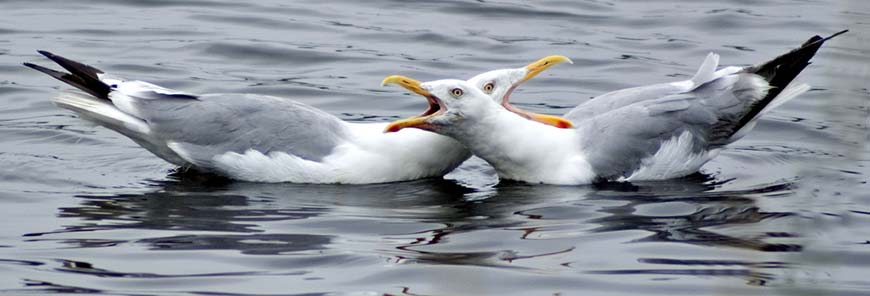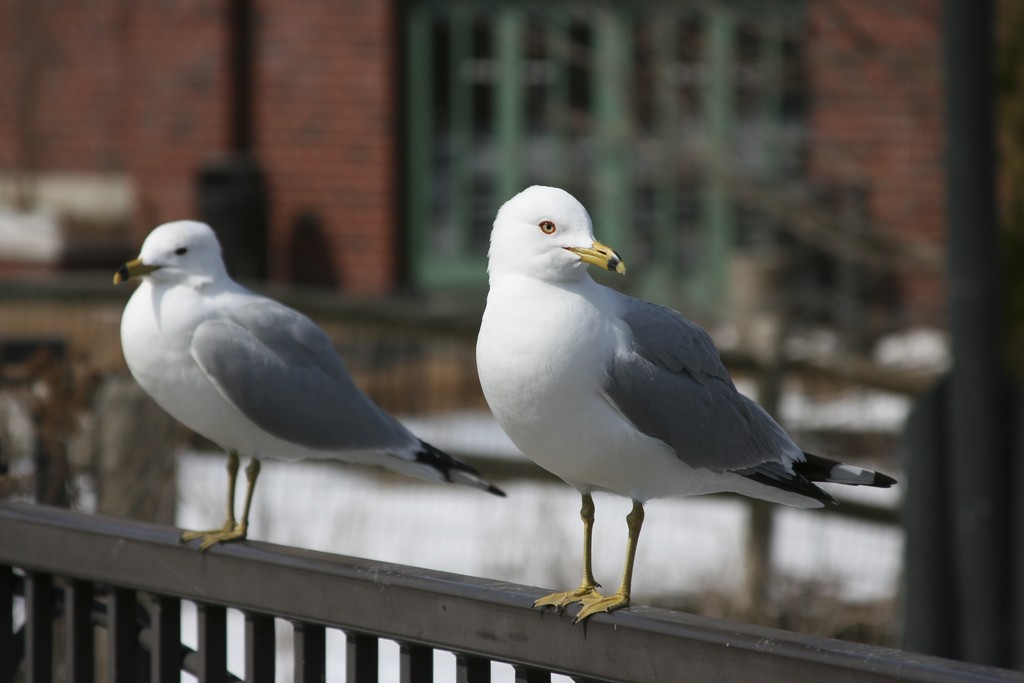Gulls: Long time, No sea

Pair of herring gulls in a more conventional waterfowl setting. Photo: PhotoJeff, Creative Commons, some rights reserved
I’m all for gender integration, but really, sometimes gulls and buoys don’t go together. While it’s true most gulls spend much or all of their lives near salt water, some, notably the ring-billed gull, live hundreds if not thousands of miles inland and may never see the sea.
There are about fifty species of gulls, often called seagulls, worlwide. They range in size from the little gull (kudos there for description, if not creativity), that weigh about four ounces, to the great black-backed gull that tips the scale at four pounds. They can be found the world over from the high arctic to Antarctica, although they are less numerous in tropical areas.
Gulls are monogamous and have a single mate for life. Colonial breeders, they return to the same site year after year. In an interesting twist of gender roles, a few males will provide daycare for a colony’s developing chicks while other adults are out getting food. Males also take turns with females to incubate eggs.
Although gulls may have a tiny noggin, they are by no means bird-brained. Fast learners, they adapt to all sorts of new environments and are quick to exploit novel food sources. Technically speaking, gulls are opportunistic omnivores. This means they’re on a “see-food” diet—if they see food, they eat it.
If necessary, they’ll catch and eat everything from fish and mollusks to rodents and earthworms, but they prefer a handout. If begging doesn’t work they scavenge and steal like the pros they are. You can find them in fields following behind a plow or manure spreader to see what tasty morsels turn up. Beaches, parking lots, and dumpsters all have riches to offer a sharp-eyed gull.
Unfortunately, the only time a lot of us take notice of gulls is when they are being a nuisance. Besides stealing French fries, they carry garbage from landfills to nearby properties, and damage buildings when they site large nesting colonies atop roofs. By and large, though, gulls serve an important role cleaning up messes, natural and human-made, with a little hunting and fishing in their spare time.
Gulls may seem plentiful, but they may be under threat if a recent trend continues. Since 1963 when Type E botulism was first identified in the Great Lakes, sporadic incidents have resulted in fish and waterbird kills. However, beginning in 2006, frequent and widespread botulism outbreaks have caused unprecedented die-offs that killed tens of thousands of gulls, loons, herons, cormorants, mergansers, and other species.
The fall of 2014 was especially bad. Hundreds of waterfowl washed ashore at a time on the lower great Lakes, including Lake Ontario. Apparently several invasive aquatic species, the round goby in particular, are to blame for this situation.

A pair of ring-billed gulls with an eye on the main chance. Photo: Kerry Lannert, Creative Commons, some rights reserved
New York State is home to four breeding gull species: the great black-backed, herring, ring-billed, and laughing gulls. Quite a few additional species pass through the State during migrations, especially on Lake Champlain, the St. Lawrence River, and the mid- to lower Hudson River. Less-common species such as Franklin’s gull or the visually striking ivory gull may mix in with resident species.
The two gulls you’re most likely to encounter are the herring and ring-billed. The most common gull on the Atlantic coast, herring gulls are stout gray-and-white birds with pink legs, generally seen squabbling over picnic remains or whatever the tide brought in. For some reason, herring gulls in the UK have gotten especially cranky, and in the summer of 2015 were reported to have injured people and pets, killing a tortoise and two small dogs. (Eat your heart out, Alfred Hitchcock.)
Ring-billed gulls are smaller than herring gulls, with thinner bills that have—no surprise—a dark band encircling them. These medium-size gulls are ubiquitous throughout the Great Lakes region as well as in the Midwest. Like most gulls, they migrate in winter, but often to the mid-Hudson or other open fresh water, not the ocean. Even with a life far removed from the sea, the ring-billed gull seems nonetheless happy as a clam. Maybe one with no gulls around.
Paul Hetzler is a horticulture and natural resources educator with Cornell Cooperative Extension of St. Lawrence County.







